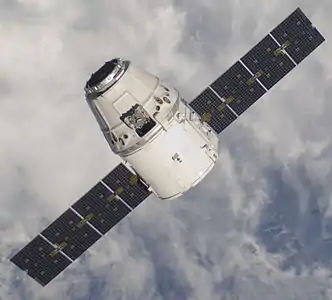SpaceX CRS-24
SpaceX CRS-24, also known as SpX-24, is a Commercial Resupply Service mission to the International Space Station planned to be launched on November 10, 2021.[1] The mission is contracted by NASA and will be flown by SpaceX using a Cargo Dragon. This will be the fourth flight for SpaceX under NASA's CRS Phase 2 contract awarded in January 2016.
| Mission type | ISS resupply |
|---|---|
| Operator | SpaceX |
| Spacecraft properties | |
| Spacecraft | Cargo Dragon |
| Manufacturer | SpaceX |
| Dry mass | 9525 kg |
| Dimensions | Height: 8.1 m Diameter: 4 m |
| Start of mission | |
| Launch date | November 10, 2021 (planned)[1] |
| Rocket | Falcon 9 |
| Launch site | Kennedy Space Center, LC-39A |
| Contractor | SpaceX |
| Orbital parameters | |
| Reference system | Geocentric orbit |
| Regime | Low Earth orbit |
| Inclination | 51.66° |
| Docking with ISS | |
| Docking port | Harmony |
| RMS capture | 2021 |
| Docking date | 2021 |
Cargo Dragon
SpaceX plans to reuse the Cargo Dragons up to five times. The Crew Dragon capsules, used on missions with astronauts, are not planned to be initially reused. The Cargo Dragon will launch without SuperDraco abort engines, without seats, cockpit controls and the life support system required to sustain astronauts in space.[2][3] This newer design provides several benefits, including a faster process to recover, refurbish and re-fly versus the earlier Dragon CRS design used for ISS cargo missions.[4]
The new Cargo Dragon capsules under the NASA CRS Phase 2 contract will splash down under parachutes in the Atlantic Ocean, east of Florida, rather than the previous recovery zone in the Pacific Ocean west of Baja California.[2][4]
Primary Payload
NASA contracted for the CRS-24 mission from SpaceX and therefore determines the primary payload, date of launch, and orbital parameters for the Cargo Dragon.[5]
- Science investigations: 0 kg (0 lb)
- Vehicle hardware: 0 kg (0 lb)
- Crew supplies: 0 kg (0 lb)
- Spacewalk equipment: 0 kg (0 lb)
- Computer resources: 0 kg (0 lb)
- External payloads: 0 kg (0 lb)
Deployable Space Systems' Solar Arrays, with new XTJ Prime space solar cells, will be delivered to the station in pairs in the unpressurized trunk of SpaceX Dragon cargo spacecraft during three (3) resupply missions beginning with the CRS-22 mission in May 2021. Another Pair will be delivered to the ISS will be on CRS-23, followed by CRS-24. The installation of each new solar array will require two (2) spacewalks: one to prepare the worksite with a modification kit and another to install the new panel.[6][7]
Research
The new experiments arriving at the orbiting laboratory will inspire future scientists and explorers, and provide valuable insight for researchers.
NASA Glenn Research Center studies: [8]
Cubesats
ELaNa 37 : Twelve (12) CubeSats planned for deployment on this mission:[9]
- CapSat-1 - The Weiss School, Palm Beach Gardens, Florida
- D3 - University of Florida, Gainesville, Florida
- GWSat - George Washington University, Washington, D.C.
- JAGSAT - University of South Alabama, Mobile, Alabama
- LEOPARDSat-1 - University of Cincinnati, Cincinnati, Ohio
- MARIO - University of Michigan, Ann Arbor, Michigan
- NACHOS - Los Alamos National Lab, Los Alamos, New Mexico
- OreSat - Portland State University, Portland, Oregon
- PATCOOL - NASA KSC, Kennedy Space Center, Florida and the University of Florida
- petitSat - NASA GSFC, Goddard Space Flight Center, Maryland
- REALOP - University of California - Davis, Davis, California
- SPORT - NASA MSFC, Marshall Space Flight Center, Alabama
References
- "Microgravity Research Flights". Glenn Research Center. NASA. 22 April 2020. Retrieved 27 September 2020.
 This article incorporates text from this source, which is in the public domain.
This article incorporates text from this source, which is in the public domain. - OIG Staff (26 April 2018). Audit of Commercial Resupply Services to the International Space Center (PDF). NASA Office of Inspector General (Report). IG-18-016. NASA. p. 24. Retrieved 29 September 2020.
 This article incorporates text from this source, which is in the public domain.
This article incorporates text from this source, which is in the public domain. - "Dragon 2 modifications to Carry Cargo for CRS-2 missions". Teslarati. Retrieved 27 September 2020.
- Clark, Stephen (2 August 2019). "SpaceX to begin flights under new cargo resupply contract next year". Spaceflight Now. Retrieved 29 September 2020.
- "SpaceX Commercial Resupply". ISS Program Office. NASA. 1 July 2019. Retrieved 27 September 2020.
 This article incorporates text from this source, which is in the public domain.
This article incorporates text from this source, which is in the public domain. - "ISS Research Program". Glenn Research Center. NASA. 1 January 2020. Retrieved 27 September 2020.
 This article incorporates text from this source, which is in the public domain.
This article incorporates text from this source, which is in the public domain. - "Upcoming ELaNa CubeSat Launches". NASA. 6 May 2020. Retrieved 27 September 2020.
 This article incorporates text from this source, which is in the public domain.
This article incorporates text from this source, which is in the public domain.

.jpg.webp)

